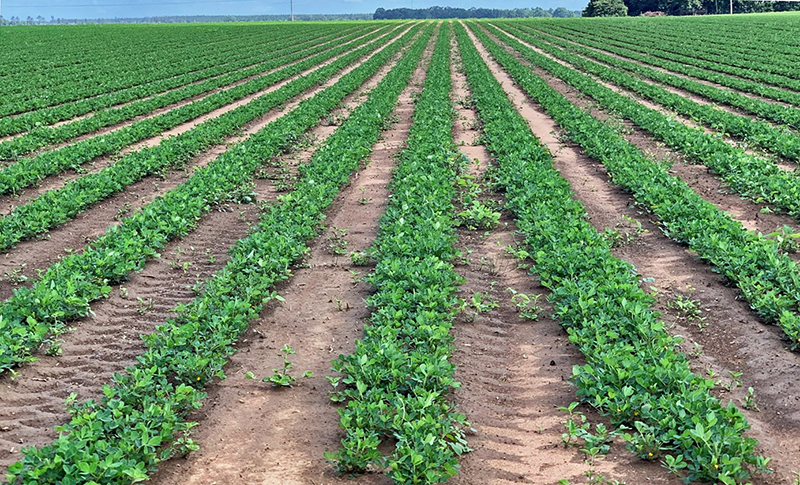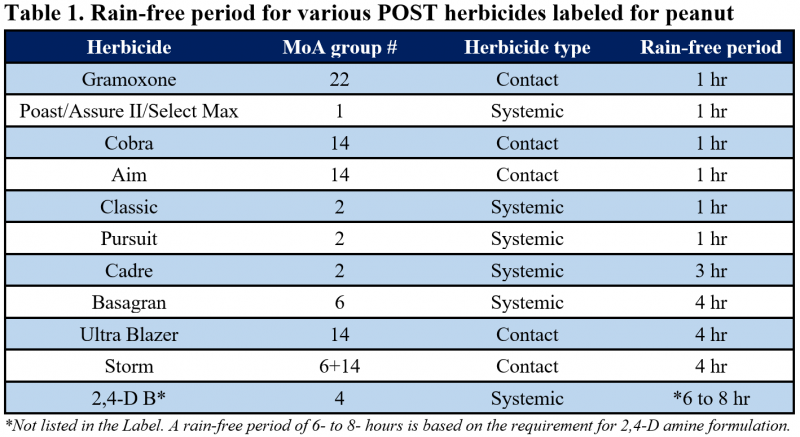Pratap Devkota, Weed Scientist, UF/IFAS West Florida Research and Education Center, Jay, FL
The 2021 peanut planting season is winding down. Most fields in the Florida Panhandle have been planted by now. Hopefully, they also received a good residual preemergence (PRE) herbicide program either by soil incorporation or at planting applications. The application of PRE herbicides will be the key for weed control and it will prove its merit as we move towards mid-season. However, for many dryland fields there was a period of drought after planting, resulting in herbicides not being activated in a timely manner. Recent rainfall should have activated PRE herbicides. If a field received rain within 7 to 10 days after herbicide application, reasonable activity from those herbicides should still be expected. Longer periods without activating rain will likely reduce overall efficacy, particularly if there was enough moisture present for weed seeds to germinate prior to the activating rain event. The PRE applied herbicides will start to breakdown about 4 to 6 weeks after application (depending upon weather conditions).

This peanut field is ready for spraying early POST herbicide treatments. Credit: Pratap Devkota, UF/IFAS West Florida Research and Education Center Jay, FL. Credit: Pratap Devlota, UF/IFAS
–
As you have a long peanut season ahead, you need to apply herbicides at least 2 to 3 times to maintain weed control throughout the season. There are several herbicides (listed in Table 1 at bottom) which can be applied after peanut has emerged (POST). These products need to be selected based on field scouting and proper weed identification. Tank mixing POST products can increase overall efficacy and broaden the spectrum of weeds controlled.
Questions to ask when tank-mixing different herbicides
- Are herbicide products from different mode of action groups?
- Do they provide activity for various weeds species present in the field?
- Are they contact or systemic products?
- Do they have any compatibility issues during tank-mixing?
Good practices for tank-mixing herbicides
- Check the herbicide label(s) for recommended tank-mix partners
- Select products from different mode of action group
- Avoid mixing contact and systemic type products
- If needed do a quick “Jar Test” to determine if there are any compatibility issues in the tank-mix
–
I would strongly recommend tank-mixing a residual herbicide during POST applications. This is crucial for keeping weeds under control throughout the season. Most of the POST herbicides do not provide residual activity, so any weeds that emerge after the herbicide application will not be affected. However, tank-mixing residual herbicides during POST application will control weeds which emerge for 3-4 weeks after application. Currently, there are 3 residual herbicides which can be tank-mixed with other POST herbicides for peanuts in Florida.
- Zidua (Group # 15) can be applied from at-cracking stage to beginning of pod development stage.
- Outlook (Group # 15) can be applied up to 80 days before peanut harvest.
- Dual Magnum or similar products (Group # 15) can be applied up to 90 days before peanut harvest.
–
Applying POST herbicides in optimum environmental conditions is often a challenge. Sometimes, we have to make POST application despite some chance of rain, and there is always the possibility of a pop-up shower/thunderstorm within short period after application. These situations can cause concern. To gauge impact of rain, we need to know the rain-free period for herbicide being applied. The rain-free period is the amount of time required after application and before rainfall for POST herbicides to work effectively. Consider rain-free period (as shown in Table 1) before applying herbicide with rain in the forecast.
–
–
If your PRE herbicide program was negatively impacted by drought conditions it will be crucial to implement a strong POST herbicide program this season. A strong program will most likely need to utilize well planned tank mixes including a product(s) with a residual component. For assistance developing your POST weed control program contact your local UF/IFAS Extension Agent.
–
More information
UF Weed Management in Peanuts
UGA Pest Management Handbook – Peanuts

